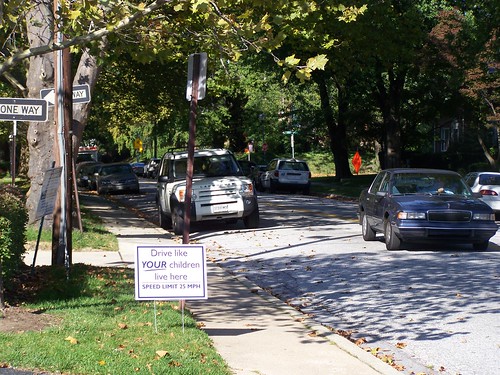Walk to School Day is Wednesday October 8th
 Rodgers Forge Neighborhood, Baltimore County.
Rodgers Forge Neighborhood, Baltimore County.Walk to school programs are important initiatives that have the potential to improve neighborhoods more generally, because infrastructure that supports students walking (and biking) to school improves sidewalk and biking infrastructure for everyone in a neighborhood, not just students.
-- International Walk to School Day webpage
My favorite resources on walking and biking to School include:
- School Walk and Bike Routes: A Guide for Planning and Improving Walk and Bike to School Options for Students, Washington State
- school mapping requirements for all K-5 schools in Washington State, with the Seattle Public Schools walk zone maps as a representative example
- Boulder Valley School District, To School Program (Alternative Transportation Program) Department of Transportation, is an example of a school district level balanced transportation program serving all of the schools in the district
- Minneapolis Safe Routes to School Strategic Plan, City of Minneapolis
- National Center for Safe Routes to School
After that day, learning about the efforts of two particularly motivated mothers with a lot of time to get the program off the ground, and after learning about Boulder Valley's district-level support program, I suggested that the best way for the State of Maryland to promote walking and biking to school would be to require the school districts to address all forms of transportation, including walking and biking, systematically, and at the district-level, rather than focusing solely on school bus transportation--rather than to hope for the best, that parents at various schools would develop Safe Routes to Schools programs on their own.

Efforts by the auto industry to promote driving kids to school are long standing, as this ad from a 1923 issue of the Saturday Evening Post illustrates.
2. I am disappointed that in the Washington, DC region, we don't have systematic efforts comparable to Colorado's Boulder Valley School District, although DC and the city department of transportation come the closest, although my sense is there is less focus on the charter schools than the traditional public schools--one problem with charter schools is that they increase car trips significantly compared to in-neighborhood schools.
The Washington Post did cover Walk to School efforts in their "Kid Post" section last week ("Walking school bus' powered by kids' feet") and there will be a number of events at public and charter schools in the city, including on Capitol Hill in Lincoln Park, where 15 schools will participate jointly.
 Ironically, Arlington's school district doesn't systematically promote walking and biking to school even though the County is a national leader in sustainable transportation practice, although this year the school district will be doing events at every school on Walk to School Day.
Ironically, Arlington's school district doesn't systematically promote walking and biking to school even though the County is a national leader in sustainable transportation practice, although this year the school district will be doing events at every school on Walk to School Day.The City of Takoma Park, Maryland does fund a Safe Routes to School promotion effort, to work with the public and private schools located in the city, but that is an effort not officially sanctioned by the Montgomery County School System--their Department of Transportation webpage only addresses buses.
This Wednesday, Montgomery County will be highlighting Walk to School Day at Rolling Terrace Elementary School in Takoma Park ("Leggett, Starr, Holmes and Local Officials to Celebrate International Walk To School Day with Rolling Terrace Elementary School ," County press release) at 8:30am.
3. Interestingly, MCPS students under the auspices of the Montgomery County NAACP Youth Council have called on the school district:
to look into what can be done to help students who walk around busy roads or use public transportation to get to and from class.... [and] shared the group’s request for possible measures such as providing bus transportation or paying for Ride On bus passes for affected students.But they haven't specifically advocated in a systematic manner for sustainable transportation options according to the Gazette ("Students look to school board for help with walking, busing issues: Youth group says busy roads around Northwest aren’t safe").
Separately, the MCDOT has a student pedestrian safety campaign ("Montgomery launches ‘YOLO’ campaign aimed at student pedestrians," Gazette) and a number of resources on Safe Routes to School.
Note that Safe Routes to School programs mostly focus on younger grades, and tend to ignore high school aged students, which I think is a mistake, given the number of pedestrian fatalities involving teens.
School bus transportation costs at least $600/student/year. Plus the cost of buses and fuel continues to rise, not to mention that it is increasingly difficult to hire and retain drivers.
4. Bike to School Day. Some communities do both biking and walking promotion in October, which makes sense because it is close to the start of the school year, and helps to routinize sustainable transportation behavior for the entire in year.
But in May, 2012, promotion of a separate Bike to School Day began, as part of "May is Bike Month" activities, in some places ("National Bike to School Day Catches On," NCSRTS)
I will say that I see a lot more children biking to school in the Capitol Hill neighborhood of DC when I am there regularly on Mondays. Similarly, an increasing number of children are biking to school in my neighborhood, Manor Park, to the Capital City Public Charter School.
A family biking to school on 3rd Street NW in the Manor Park neighborhood of Washington, DC.
Labels: car culture and automobility, children in the city, pedestrian safety, public education/K-12, sustainable transportation, traffic safety and enforcement, urban design/placemaking





0 Comments:
Post a Comment
<< Home